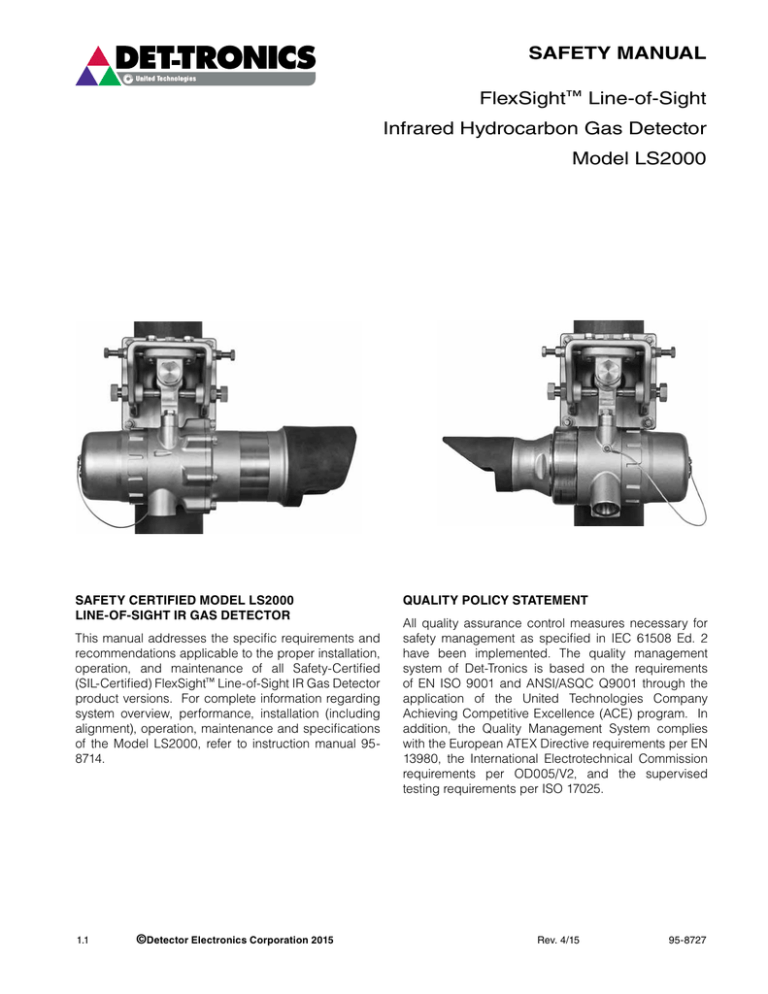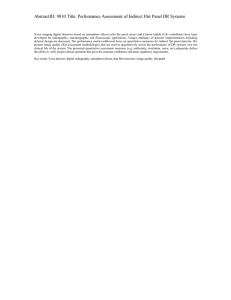
SAFETY MANUAL
FlexSight™ Line-of-Sight
Infrared Hydrocarbon Gas Detector
Model LS2000
SAFETY CERTIFIED MODEL LS2000
Line-of-sight IR GAS DETECTOR
This manual addresses the specific requirements and
recommendations applicable to the proper installation,
operation, and maintenance of all Safety-Certified
(SIL‑Certified) FlexSight™ Line-of-Sight IR Gas Detector
product versions. For complete information regarding
system overview, performance, installation (including
alignment), operation, maintenance and specifications
of the Model LS2000, refer to instruction manual 958714.
1.1© Detector Electronics Corporation 2015
QUALITY POLICY STATEMENT
All quality assurance control measures necessary for
safety management as specified in IEC 61508 Ed. 2
have been implemented. The quality management
system of Det-Tronics is based on the requirements
of EN ISO 9001 and ANSI/ASQC Q9001 through the
application of the United Technologies Company
Achieving Competitive Excellence (ACE) program. In
addition, the Quality Management System complies
with the European ATEX Directive requirements per EN
13980, the International Electrotechnical Commission
requirements per OD005/V2, and the supervised
testing requirements per ISO 17025.
Rev. 4/1595-8727
SAFETY MESSAGES
DESIGN
Procedures and instructions in this section may
require special precautions to ensure the safety of
personnel performing the operations. Information that
raises potential safety issues is indicated by the word
“Warning”. Always read and understand these safety
messages.
The Model LS2000 Line-of-Sight Gas Detector is an
infrared hydrocarbon gas detector that is classified as
Type B smart device according to IEC61508. It provides
an isolated 4-wire 4-20 mA output that is proportional to
hydrocarbon vapor concentrations from 0-5 LFL-meters.
The LS2000 contains extensive self-diagnostics and is
programmed to send the current output to a specified
failure state upon internal detection of a failure (see
LS2000 instruction manual for fault output level details).
Optional Alarm and Fault relay contact outputs are
available in addition to the analog signal output, and
can be programmed in the field by the user. The Safety
Certification for the LS2000 Gas Detector includes both
the standard version with analog output only and the
version with optional relay outputs. The relay output
and analog output are not to be used in combination
for the safety function.
WARNING
The Model LS2000 Gas Detector is intended for
use in hazardous environments that may include
explosive levels of flammable gases and vapors.
This product must be properly installed, operated
and maintained. Improper installation or use
could result in an explosion or fire resulting in
death or serious injury.
• Do not remove the wiring compartment cover
in explosive environments when device power
is on and circuits are live.
Safety-Certification of the LS2000 includes:
• Detector must be properly installed, and wiring
compartment cover must be fully engaged
to meet hazardous area explosion-proof/
non‑incendive requirements.
• the 4-20 mA output
• the Fault, Low Alarm, and High Alarm Relay outputs
The HART communication protocol is non-interfering
and can be used for diagnostics within the SIL 2
safety loop in the Safety operation mode. Diagnostics
are defined as read only information. Local HART
communication with the LS2000 IR Gas Detector is
acceptable. Proper analog signal loop resistance must
be installed as documented in the instruction manual to
enable local HART communication.
• Before connecting a HART field communicator
to the LS2000 IR Gas Detector in a potentially
explosive atmosphere, make sure the field
communicator is suitable and approved for
use in the specific area.
1.1
2
95-8727
VALID INPUT RANGE
INSTALLATION
LS2000 fault annunciation is provided on the 4-20 mA
signal output loop by signaling to a specific mA current
output level. The receiving device must be programmed
to indicate a fault condition when current levels reach an
under-current level of 3.6 mA or less, or an over-current
level of 21 mA or more.
NOTE
For complete information regarding performance,
installation,
operation,
maintenance
and
specifications of Model LS2000, refer to
instruction manual 95‑8714.
No special or additional detector installation
requirements exist above and beyond the standard
installation practices documented in the Model LS2000
instruction manual.
NOTE
The LS2000 analog signal and relay outputs
are not safety-rated during detector warm-up,
alignment mode, calibration mode, or during
signal output loop testing. Alternative means
should be used at the job site to ensure facility
safety during these activities.
Specifications regarding environmental operating
conditions for the LS2000 Detector are applicable as
published in the general specifications section in the
instruction manual. The device shall not be exposed to
environments that exceed its specified environmental
limits.
DIAGNOSTIC RESPONSE TIME
The LS2000 Infrared Gas Detector will perform all
critical diagnostic functions within 1 hour, worst case
diagnostic detection time.
The LS2000 operating power distribution system should
be designed and installed so the terminal voltage does
not drop below 18 Vdc when measured at any specific
location. The maximum current limit per transmitter or
receiver must be less than 2 amperes. The external
system providing power to the LS2000 must have overvoltage protection that ensures supply voltage does not
exceed 30 Vdc.
CERTIFICATION
The LS2000 Safety-Certified version is certified by
exida® to IEC 61508 Ed. 2 for single input use in low
demand, SIL 2 Safety Instrumented Systems.
SAFETY-CERTIFIED PRODUCT IDENTIFICATION
Safety Certification of all LS2000 models meeting SIL
2 safety standards is clearly identified on the product
label.
1.1
3
95-8727
Common Misuse Scenarios
Relay Configuration Requirements
• Do not install the LS2000 on unstable or vibration
prone structures; a 3 meter maximum height is
recommend when using a vertical post.
The LS2000 gas detector’s Low Alarm, High Alarm and
Fault relay outputs may be used as part of a Safety
Certified system. The end user must provide transient
and current limiting on the output contacts of the relays.
The maximum relay contact output must be limited to
5 amperes at 30 Vdc. The load must be a resistive
load. The user must protect against transients by using
standard protection methods such as proper grounding
of shielded wire and separation of relay load wires from
other lines carrying rapidly switched high current (e.g.
large motor power supply lines).
• Do not install the LS2000 below the height of typical
human activity unless absolutely necessary in order
to prevent nuisance beam block faults.
• Do not install the LS2000 receiver where multiple
transmitters are in the line of sight - this is a common
concern for pipeline system installations.
NOTE
The above common misuse scenarios will cause
the LS2000 to annunciate a fault if the condition
is severe enough to compromise the safety
function.
Configuration Protection
Upon completion of installation and commissioning,
it is recommended to password-protect the LS2000
programming and setup function using a HART Field
Communicator or AMS program to prevent accidental
or deliberate change of detector configuration data
during normal operation.
START-UP AND COMMISSIONING
Commissioning Personnel
The Safety Certified LS2000 gas detector can be
commissioned by any qualified person with knowledge
of gas detection instruments and the configuration
device being used. Refer to the Start‑Up, Alignment
and Calibration sections provided in the LS2000
instruction manual.
OPERATION, MAINTENANCE, INSPECTION AND
PROOF TESTING
All normal installation, start-up, and field calibration
recommendations as documented in the STARTUP
section of the LS2000 instruction manual are applicable
to the Safety Certified LS2000 gas detector.
Configuration
Safety-Certified LS2000 gas detectors require
additional Proof testing to be performed in all cases.
Digital communication with the LS2000 is necessary
to monitor internal status and to modify the factory
settings. Appendix D of the LS2000 instruction
manual provides guidance on establishing HART
communication, and describes the communication
menu structure when using the LS2000 with the HART
Handheld Communicator. Personnel performing Proof Test procedures shall be
competent to perform the task. All proof test results
must be recorded and analyzed. Any corrective actions
taken must be documented in the event that an error is
found in the safety functionality. The Proof tests must be
performed at a frequency as shown in Table 1.
NOTE
Prior to device configuration (setting alarm
thresholds, latch/non-latch function, etc.) all
alarm outputs must be bypassed. The device is
not safety certified during configuration change
activities.
warning
Failure to perform the specified testing and
inspection may lower or void the SIL rating for the
product or system.
Table 1—Frequency for Performing Proof Tests
1.1
LS2000 Proof Test Name
Commissioning
Frequency per Year
Gas Response Proof Test
Yes
1
Output Response Proof Test
Yes
1
4
95-8727
Zero Calibration
GAS RESPONSE PROOF TEST
Tools Required:Magnet
WARNING
Any external alarm equipment, systems or
signaling devices that could be automatically
initiated by performing this test must be disabled
or bypassed before performing this test!
Zero Calibration shall be conducted when required as
documented in the Calibration section of the LS2000
instruction manual. It is permissible to initiate the Zero
Calibration using the onboard magnetic switch, digital
communication via HART or MODBUS communication,
or the remote calibration line. In all cases, the LS2000
gas detector should be allowed to warm up for one
hour minimum before conducting calibration.
Optical Test Film Method (Recommended)
Tools Required: LS2000 System Test Film
P/N: 012673-001
The test film provides a means of testing the operation
of the Model LS2000 IR Gas Detector. When the test
film is placed in the beam of the line-of-sight detector,
the detector output will rise to a specific value.
NOTE
The last hundred (100) Calibration procedures
are logged with a time stamp in the LS2000
onboard memory.
The LS2000 test film packet consists of five separate
test film cards. A single card can be used, or the
cards can be “stacked” to simulate up to five different
gas concentrations. Light shining through one card
corresponds to the lowest LFL-m for a particular gas,
while light shining through all five cards corresponds to
the highest LFL-m reading for a particular gas. Table 2
shows the response of the three standard LS2000 gas
type settings to each of the five test film values.
Successful completion of the Gas Response Proof Test
must be recorded and documented in the SIS logbook.
Table 2—Typical System Response* in LFL-M (% Full Scale)
Using Gas Test Films
Proper operation can be confirmed by bypassing all
system alarms, then placing the optical test film into the
light beam and checking for the appropriate 4-20 mA
output level or relay actuation.
Alarm conditions, if present, should clear when the test
film is removed from the beam (in non-latching mode,
see LS2000 instruction manual for details).
The test film is typically used to verify the factory
calibration of the LS2000. The test film is not intended
for routine use. It does, however, demonstrate in a very
direct way the response of the detector to hydrocarbons
along with the resulting control action. This is particularly
useful when required by regulatory authorities.
Methane
Butane
Propane
1
0.6
(12%)
1.1
(22%)
1.3
(26%)
2
1.5
(29%)
2.3
(46%)
2.6
(52%)
3
2.5
(50%)
3.6
(72%)
3.9
(78%)
4
3.7
(74%)
4.9
(98%)
5.4
(108%)
5**
5.0
(100%)
6.0
(120%)
6.0
(120%)
*Accuracy = ±0.2 LFL-M or ±15% LFL-M from typical system
response, whichever is greater.
For complete information regarding proper use of the
test film and testing of the LS2000 detector, refer to the
LS2000 manual number 95-8714.
1.1
Test Film
(Number of Cards)
**A HART handheld device is needed to read over-range values.
5
95-8727
OUTPUT RESPONSE PROOF TEST
FAULT/FAILURE ACTION PLAN
In the event that a Calibration does not result in
acceptable Gas Response Proof test, then the standard
Maintenance, Troubleshooting, and Device Repair and
Return procedures as listed in the LS2000 instruction
manual must be followed. Any failure to successfully
complete the Gas Response Proof Test must be
recorded and documented in the SIS logbook and
reported to the manufacturer.
NOTE
The requirements for the Output Response Proof
Test can be waived for the 4-20 mA output if
a successful Gas Response Proof Test was
completed using the 4-20 mA output during the
required time frame. Details must be recorded in
the SIS logbook.
4-20 mA Output Model
PRODUCT REPAIR
1. Inhibit alarm response at the control device.
The LS2000 transmitter and receiver electronics
modules can be replaced in the field as listed in the
Replacing LS2000 Transmitter/Receiver Electronics
Module section of the LS2000 instruction manual. Any
internal device repairs other than electronics module
replacement must be conducted at the factory. No
firmware changes are permitted or authorized. All
failures detected by the internal diagnostics or by the
Proof Test must be reported to the manufacturer.
2. Use a HART handheld communicator to perform a
Loop Test function at 20 mA, or place an Optical
Test Film into the detector light beam (refer to
Optical Test Film Method section above). Verify
correct output at the control device.
3. Remove the optical test film, if necessary, and reactivate alarm response at the control device.
Relay Output Models
OPERATING, ENVIRONMENTAL, AND
PERFORMANCE SPECIFICATIONS
The following should be performed to verify correct
alarm and trouble relay activation.
The Safety-Certified LS2000 product versions fully
comply with, and must be operated in accordance
with, the functional, environmental (including EMC
considerations), and performance specifications
provided in the LS2000 instruction manual. A 24 hour
mean time to repair should be assumed for safety
availability calculations.
Fault Relay
1. Inhibit fault response at the control device.
2. Completely block the light beam with a solid object
such as a piece of cardboard until a beam block
fault is generated. Verify correct change of state at
the control device.
SPARE PARTS
3. Re-activate fault response at the control device.
Refer to “Spare Parts” in the LS2000 instruction manual.
Safety Certification is based on a sufficient number of
spares to achieve a 24 hour mean time to repair.
Alarm Relays
1. Inhibit alarm response at the control device.
2. Place the test film into the light beam and verify
appropriate relay actuation for the number of cards
being used (see Table 2).
3.Remove the test film to return the device to its
original state (in non-latching mode). Re-activate
alarm response at the control device.
1.1
6
95-8727
CERTIFICATION AND FAILURE RATE DATA
Additional CERTIFICATIONS
All Safety-Certified LS2000 models are certified
compliant to:
FM, CSA.
Refer to the Model LS2000 Instruction Manual for
details.
IEC61508: 2010
For complete information regarding performance,
installation, operation, maintenance and specifications
of Model LS2000, refer to instruction manual 95‑8714.
Type B Device
Systematic Capability:
SIL 2 certified
HFT: 0
TERMS AND DEFINITIONS
Low Demand Mode
FMEDA
Failure Mode Effects and Diagnostics
Analysis
PFDavg should be calculated for any safety instrumented
function using the LS2000. (Refer to FMEDA report for
necessary information, including DU rate.)
HART Highway Addressable Remote
Transducer
4-20mA SFF = 96.0%
Relay SFF = 90.9%
Safety Accuracy:
±0.2 LFL-meters or ±10% of
applied gas concentration,
whichever is greater.
Safety Response Time: <2 seconds
with 5.0 LFL-Meters applied
Product Life:
Hardware Fault Tolerance
LFL
Lower Flammable Limit
LS2000 Line-of-Sight IR Gas Detector
PFD
Probability of Failure on Demand
(Probability of Dangerous Failure)
PFDavg
Average Probability of Failure on
Demand
10 years, based on
manufacturer data.
Maximum Misalignment: ±0.8 degrees.
All failure rate data for SIL verification is in the FMEDA
report, which is available upon request.
1.1
HFT
7
SFF
Safe Failure Fraction
SIF
Safety Instrumented Function
SIL
Safety Integrity Level
SIS
Safety Instrumented System
95-8727
­Corporate Office
6901 West 110th Street | Minneapolis, MN 55438 USA
Operator: 952.941.5665 or 800.468.3244
Customer Service: 952.946.6491 or 800.765.3473
www.det-tronics.com | Email: det-tronics@det-tronics.com
Specifications subject to change without notice.
All trademarks are the property of their respective owners.
© 2015 Detector Electronics Corporation. All rights reserved.
95-8727



